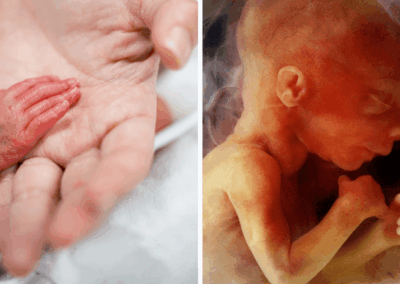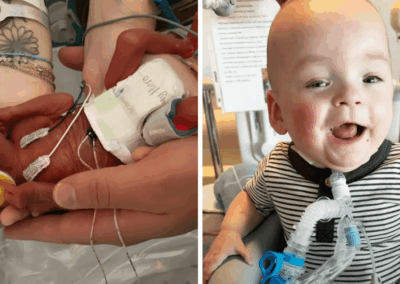A baby girl who was around the same size as her teddy bear when she was born 12 weeks early has now been able to go home.
Baby Sutton’s mother Kennedie started to experience illness during her pregnancy and went to the hospital. Following a medical appointment where some complications were identified, Kennedie was then airlifted to the IWK Health Centre in Halifax, Nova Scotia, with her husband Jesse driving over to join her.
“Flash-forward about a week after we were there, Sutton was born at a whopping one pound, 15 ounces”, Jesse said.
At just 29 and a half weeks gestation, Sutton required a lot of specialist care.
“It was a very traumatic situation. From double-digit people in the room, to Kennedie being cared for and Sutton being rushed off to the neonatal unit. Me going with the baby and leaving Kennedie behind, but not knowing where to go or which direction to go in”, said Jesse.
Fighting for life from the start
However, Sutton proved at an early stage how resilient she was.
“From moment one, she was just unbelievable”, her mother Kennedie said. “She was breathing on her own; she didn’t use very much oxygen when she was born”.
Sutton’s parents took photos of her alongside her teddy bear to show how much she had grown. When she reached the weight threshold of one kilogram, she was allowed to transfer to a hospital closer to home, although she remained in the neonatal intensive care unit.
Kennedie said that she and Jesse were informed about the health problems that premature babies often have.
“She was born 12 weeks early. They obviously come in and tell us all the possibilities of her future health… high risk of deafness, blindness, high risk of cerebral palsy”, she said.
“Then just obvious stuff like the muscle tone, her lung development… being able to eat food and stuff properly because she was on a feeding tube for so long.… She had to be taught how to eat”.
However after weeks in intensive care, Sutton was able to return home with relatively few health difficulties. Her parents shared that she takes medication for congenital hyperthyroidism and is being reviewed by cardiologists for pulmonary stenosis, which is the narrowing of a valve in her heart.
“I tell her every single day how brave she is for everything that she’s gone through”, said Kennedie. “There’s people who wouldn’t be able to fight like she did”.
“She’s the love of my life and Kennedie’s life. She’s just our everything”, said Jesse. “She’s overcome so much already. It’s honestly hard to believe how much she’s been through, and how she shows us just how much fight she has inside of her”.
Medical advances have left a contradiction at the heart of our abortion law
Babies like Sutton who are born prematurely require specialist medical care to ensure they have the best outcomes possible. Improvements in this medical care have left a clear contradiction at the heart of our abortion law and current medical practice.
On the one hand, the law permits ending the lives of babies at 22 and 23 weeks, and, on the other hand, current medical practice strives to save the lives of many babies born prematurely at 22 or 23 weeks gestation.
The annual abortion statistics for England and Wales in 2021 reveal that 755 “ground C” abortions were performed when the baby was at 22 or 23 weeks gestation (ground C is the statutory ground under which the vast majority of abortions are permitted and there is currently a 24-week time limit for abortions performed under this statutory ground).
At the same time, according to a recent study, there were a total of 261 babies born alive at 22 and 23 weeks, before the abortion limit, who survived to discharge from hospital in 2020 and 2021.
This means in the same hospital, on the same day, two babies at the same gestational age (22 or 23 weeks gestation) could have very different fates – one could have his or her life deliberately ended by abortion, and the other could be born prematurely and have a dedicated medical team provide the best care they can to try to save his or her life.
Spokesperson for Right To Life UK, Catherine Robinson, said “We are delighted to hear that baby Sutton has been able to go home with relatively few complications from her premature birth. Every child deserves to receive the same level of care and support to live the fullest and healthiest life possible”.












